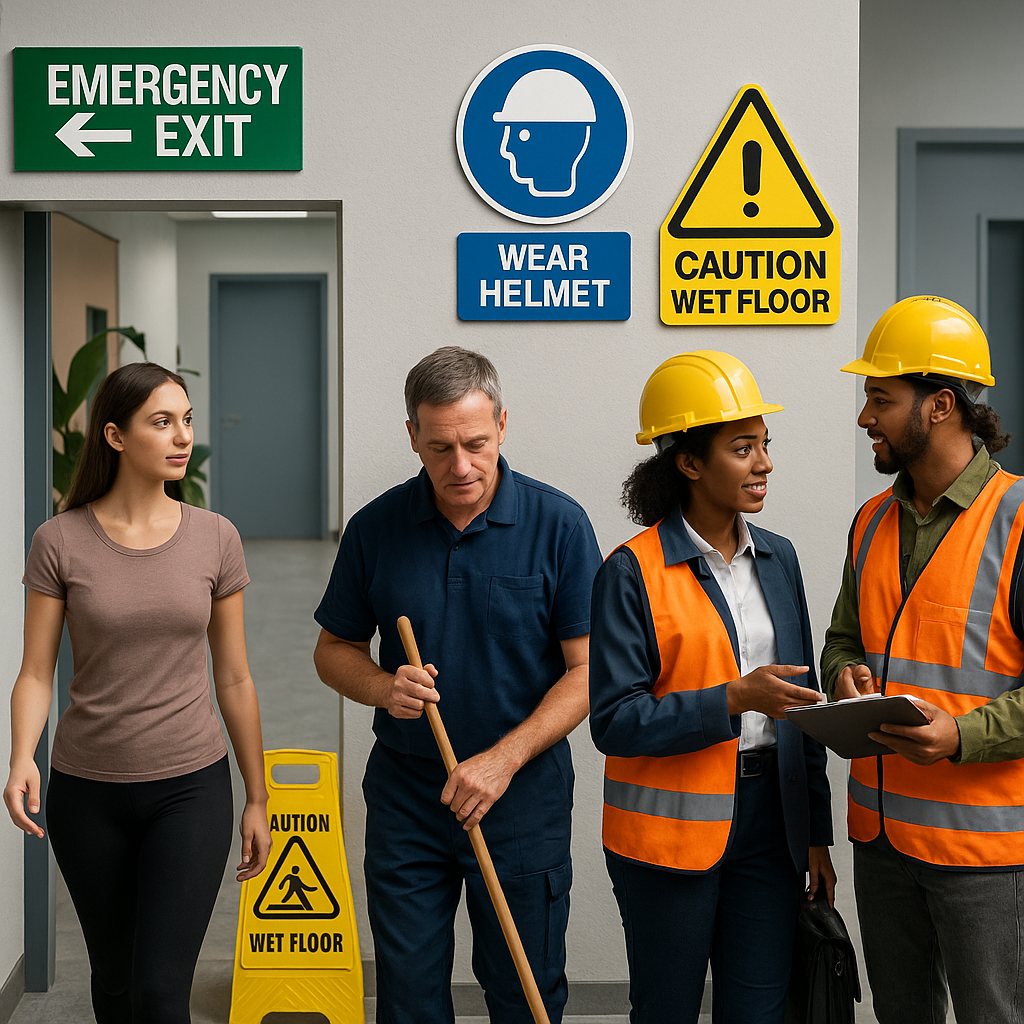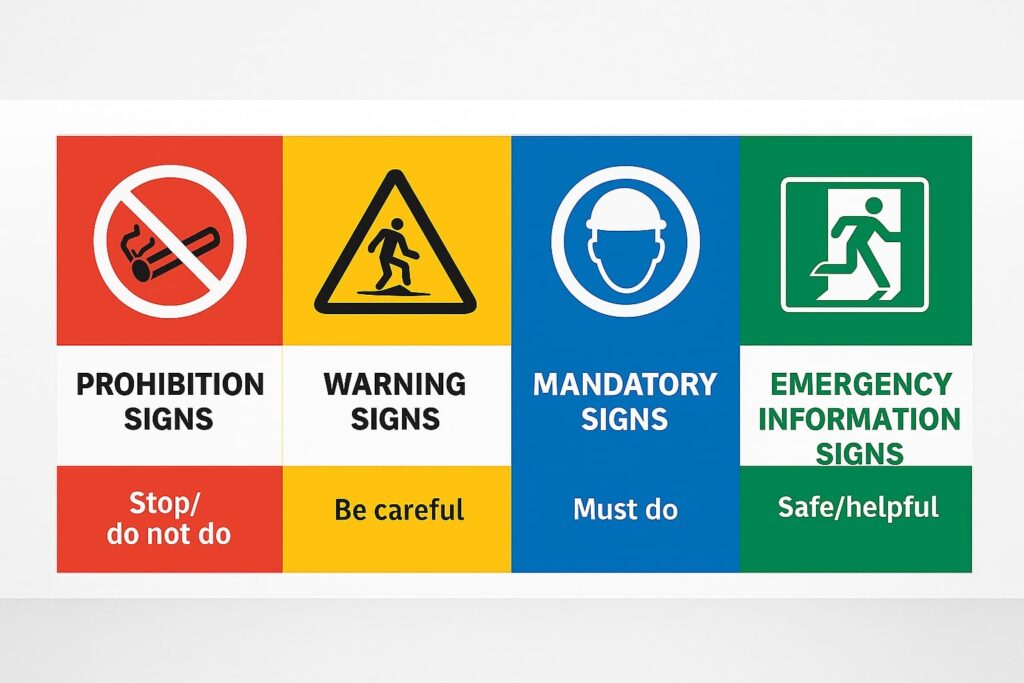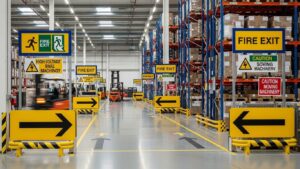Think about entering a building with no signs at all. You’d feel lost, right? That’s because health and safety signs are not for decoration, they’re for protection. They tell you what to do, what not to do, and where to go in danger.
In workplaces, they help everyone stay safe, i.e, staff, visitors, and customers. Poor signage can cause serious accidents. Total Safety says, inefficient signage is a top cause of injuries. That’s why signs must follow standards like ISO 7010 and ISO 3864 across industries. These standards ensure health & safety signs are easy to understand in any workplace.
Color also plays a big part. A study by ISHN found red safety signs create urgency and warn of immediate danger. Green signs show safety, like first aid or emergency exits. The best sign companies always follow these rules while making signs that are clear and visible. This helps workers react fast and stay safe on-site.

Purpose of Health and Safety Signs in Workplaces
Health and safety signs act like quiet helpers, guiding people every day. They give clear messages: where to go, what to avoid, and how to stay safe. These signs help workers and visitors in all kinds of buildings and job sites. Even places like fitness centres need them. Without signs, people can get confused or hurt. Health and safety signage saves lives by sharing important safety information in simple ways.
The 4 Main Types of Safety Signs and Their Roles
There are 4 types of precaution signs. Each one uses specific colors and shapes to make messages easy to understand. Let’s look at each one.
Prohibition Signs
These signs say what you must not do. They are always red with a line across a black symbol.
- Examples: “No Smoking”, “No Entry”, “Do Not Touch”.
- These Prohibition Signs stop risky actions before they happen.
- They use strong colors to grab attention fast.
Warning Signs
Warning Signs show danger that may happen if you’re not careful. They are yellow triangles with black borders and symbols.
- Examples: “Caution: Wet Floor”, “High Voltage”, “Hazard Ahead”.
- These health and safety warning signs tell people to be alert and act safely.
- They help reduce slips, shocks, or other injuries.
Mandatory Signs
Mandatory signs show what must be done; no questions asked. They are blue circles with white images.
- Examples: “Wear Safety Goggles”, “Use Hand Sanitizer”, “Wear Helmet”.
- These are mandatory health and safety signs you must follow to enter or work.
- They make sure workers follow safety rules.
Emergency Information Signs
These signs show safe places or emergency equipment. They are green with white text or images.
- Examples: “First Aid”, “Emergency Exit”, “Fire Assembly Point”.
- These Emergency Information Signs help in fire, injury, or evacuation situations.

Health and Safety Sign Colours and Their Meanings
Colors are very important in health and safety signage. Each color gives a message, even before reading the words. Let’s break them down by meaning:
- Red: Stop or do not do something. Used for fire or Prohibition Signs.
- Yellow: Be careful. Used for Warning Signs.
- Blue: Must do something. Used for Mandatory Signs.
- Green: Safe or helpful areas. Used for Emergency Information Signs.
How Safety Signs Improve Workplace Compliance
UK workplaces have to abide by the Health and Safety (Safety Signs and Signals) Regulations 1996. These laws state that signs should not be ambiguous and have to be displayed where they are needed. Workplace health and precaution signs ensure the staff and visitors understand the risks. Such signs also protect the owners of businesses from legal problems or even fines.
When you use the right health and safety signage, people feel more secure and informed. That builds trust and helps avoid accidents or mistakes.
Health and Safety Signage Rules and Guidelines
Not every sign works just by being placed anywhere. There are rules to follow. Here are some quick tips for proper signage:
- Signs must be easy to see from a distance.
- Use signs only where there is a real risk or rule.
- Match the precaution signs and meanings to the task or danger nearby.
- Use materials that last in your working conditions.
- Train staff to understand the four types of these precaution signs.
Also, update signs if rules or building layouts change. Health and precaution signs must always reflect the current risks or instructions.
Improving Workplace Safety with the Right Signage
Good signage can prevent accidents before they happen. Whether you run a retail store or a corporate building, clear signs save time and lives.
- The best sign companies, like Zero Signs UK, offer signs made for different needs.
- Their signs follow UK rules and ISO standards.
- They offer strong color contrast and simple text.
- Their signs suit all environments: offices, shops, or factories.
Choosing the right signage helps workers stay focused and follow rules easily. Blue health and advisory signs tell people what to do. Red precaution signs warn of danger. Green signs lead to help. Yellow signs alert you about hazards. Using all 4 types of these precaution signs creates a balanced and safe space.
Conclusion
From fitness centres to warehouses, every place needs the right health and precaution signs. They don’t just help meet laws, they help save lives and avoid confusion.
Using signs from professionals like Zero Signs ensures your space is clear and compliant. Always use signs that follow the right colors and shapes for best results.
Know the safety sign colours. Use the correct Prohibition Signs, Warning Signs, Mandatory Signs, and Emergency Information Signs. The right health and precaution signs in the workplace show that you care about safety. Make your space smarter, safer, and legally ready with strong health and safety signage.
Protect your business and people! Get expert health and safety signs from ZeroSigns UK today!





